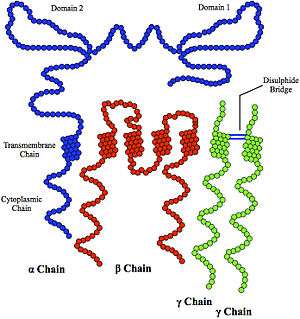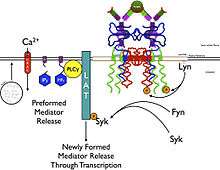FCER1
The high-affinity IgE receptor, also known as FcεRI, or Fc epsilon RI, is the high-affinity receptor for the Fc region of immunoglobulin E (IgE), an antibody isotype involved in the allergy disorder and parasites immunity. FcεRI is a tetrameric receptor complex that binds Fc portion of the ε heavy chain of IgE.[1] It consists of one alpha (FcεRIα - antibody binding site), one beta (FcεRIβ - which amplifies the downstream signal), and two gamma chains (FcεRIγ - the site where the downstream signal initiates) connected by two disulfide bridges on mast cells and basophils. It lacks the beta subunit on other cells. It is constitutively expressed on mast cells and basophils[2] and is inducible in eosinophils.


| High-affinity IgE receptor; alpha | |
|---|---|
| Identifiers | |
| Symbol | FCER1A |
| Alt. symbols | FcεRIα, FCE1A |
| NCBI gene | 2205 |
| HGNC | 3609 |
| OMIM | 147140 |
| RefSeq | NM_002001 |
| UniProt | P12319 |
| Other data | |
| Locus | Chr. 1 q23 |
| High affinity IgE receptor; beta | |
|---|---|
| Identifiers | |
| Symbol | MS4A2 |
| Alt. symbols | FcεRIβ, FCER1B, IGER, APY |
| NCBI gene | 2206 |
| HGNC | 7316 |
| OMIM | 147138 |
| RefSeq | NM_000139 |
| UniProt | Q01362 |
| Other data | |
| Locus | Chr. 1 q23 |
| High affinity IgE receptor; gamma | |
|---|---|
| Identifiers | |
| Symbol | FCER1G |
| Alt. symbols | FcεRIγ |
| NCBI gene | 2207 |
| HGNC | 3611 |
| OMIM | 147139 |
| RefSeq | NM_004106 |
| UniProt | P30273 |
| Other data | |
| Locus | Chr. 1 q23 |
Tissue distribution
FcεRI is found on epidermal Langerhans cells, eosinophils, mast cells, and basophils.[3][4] As a result of its cellular distribution, this receptor plays a major role in controlling allergic responses. FcεRI is also expressed on antigen-presenting cells, and controls the production of important immune mediators (cytokines, interleukins, leukotrienes, and prostaglandins) that promote inflammation.[5] The most known mediator is histamine, which results in the five symptoms of inflammation: heat, swelling, pain, redness and loss of function.
Mechanism of action
Crosslinking of the FcεRI via IgE-antigen complexes leads to degranulation of mast cells or basophils and release of inflammatory mediators.[6] Under laboratory conditions, degranulation of isolated basophils can also be induced with antibodies to the FcεRIα, which crosslink the receptor. Such crosslinking and potentially pathogenic autoantibodies to the FcεRIα have been isolated from human cord blood, which suggest that they occur naturally and are present already at birth. However, their epitope on FcεRIα was masked by IgE, and the affinity of the corresponding autoantibodies found in healthy adults appeared lowered.[7]
See also
References
- Kumar, Vinay; Abbas, Abul K.; Aster, Jon (2012-05-01). Robbins Basic Pathology (9 ed.). Saunders.
- Pawankar R (February 2001). "Mast cells as orchestrators of the allergic reaction: the IgE-IgE receptor mast cell network". Curr Opin Allergy Clin Immunol. 1 (1): 3–6. doi:10.1097/00130832-200102000-00002. PMID 11964662.
- Ochiai K, Wang B, Rieger A, Kilgus O, Maurer D, Födinger D, Kinet J, Stingl G, Tomioka H (1994). "A review on Fc epsilon RI on human epidermal Langerhans cells". Int Arch Allergy Immunol. 104. Suppl 1 (1): 63–4. doi:10.1159/000236756. PMID 8156009.
- Prussin C, Metcalfe D (2006). "5. IgE, mast cells, basophils, and eosinophils". J Allergy Clin Immunol. 117 (2 Suppl Mini–Primer): S450–6. doi:10.1016/j.jaci.2005.11.016. PMID 16455345.
- von Bubnoff D, Novak N, Kraft S, Bieber T (2003). "The central role of FcepsilonRI in allergy". Clin Exp Dermatol. 28 (2): 184–7. doi:10.1046/j.1365-2230.2003.01209.x. PMID 12653710.
- Siraganian RP (December 2003). "Mast cell signal transduction from the high-affinity IgE receptor". Curr. Opin. Immunol. 15 (6): 639–46. doi:10.1016/j.coi.2003.09.010. PMID 14630197.
- Bobrzynski T, Fux M, Vogel M, Stadler MB, Stadler BM, Miescher SM (November 2005). "A high-affinity natural autoantibody from human cord blood defines a physiologically relevant epitope on the FcepsilonRIalpha". J. Immunol. 175 (10): 6589–96. doi:10.4049/jimmunol.175.10.6589. PMID 16272313.
External links
- Fc+epsilon+RI at the US National Library of Medicine Medical Subject Headings (MeSH)